University Assignment: Analysis of Latureae Business Model in MIS500
VerifiedAdded on 2022/09/28
|12
|2348
|15
Report
AI Summary
This report provides a comprehensive analysis of the Latureae business model, a health and wellness company, examining its primary and secondary activities to create value. The report identifies the strategic and operational objectives of Latureae, including marketing, sales, and human resource management. It applies Porter's value chain model to identify key activities such as inbound and outbound logistics, procurement, and technological development. The analysis highlights how these activities contribute to the company's success in the market. The report also provides recommendations for enhancing employee efficiency and customer safety. It concludes by summarizing the cross-functional activities that drive value creation and the application of strategic objectives within the company.
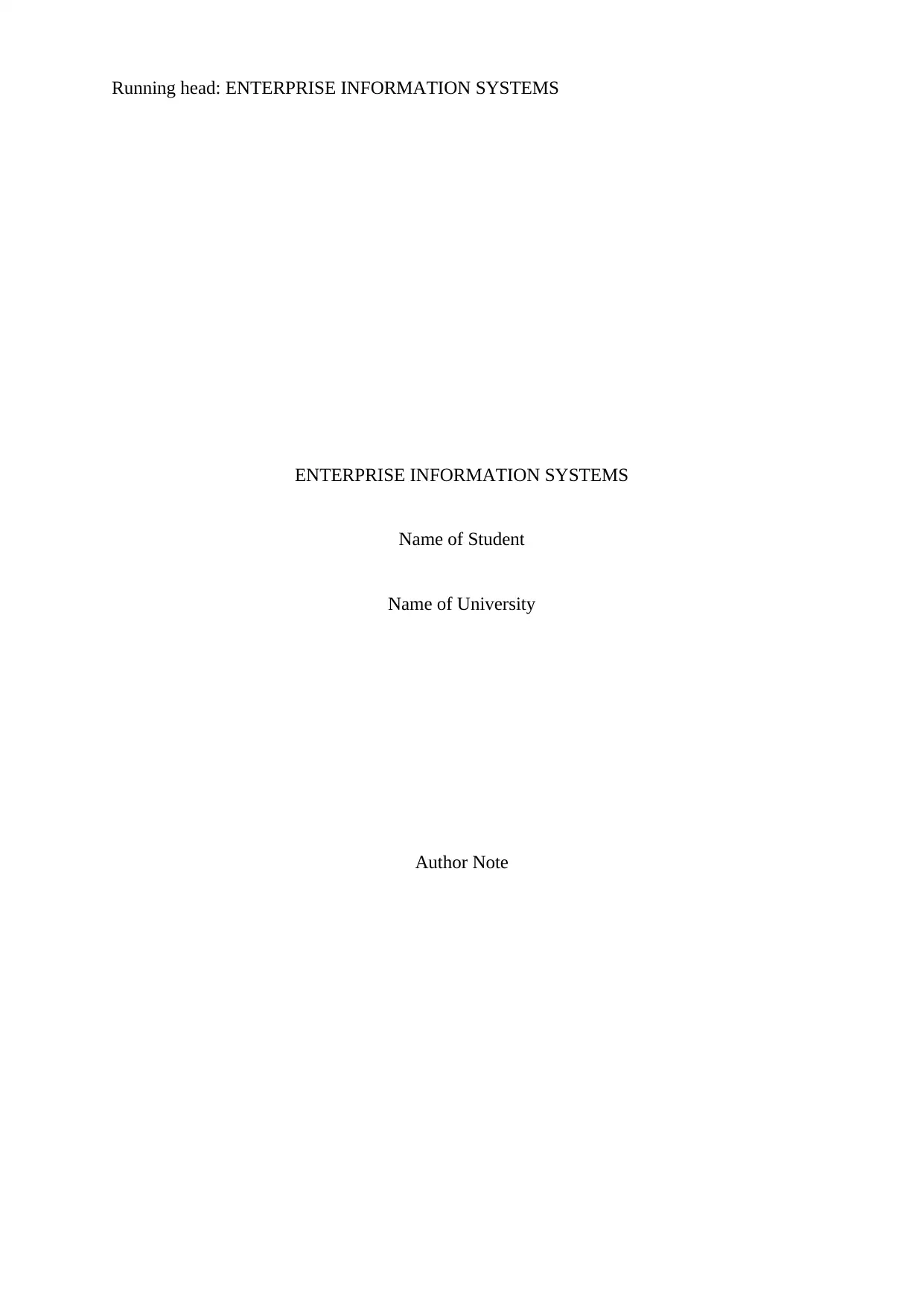
Running head: ENTERPRISE INFORMATION SYSTEMS
ENTERPRISE INFORMATION SYSTEMS
Name of Student
Name of University
Author Note
ENTERPRISE INFORMATION SYSTEMS
Name of Student
Name of University
Author Note
Paraphrase This Document
Need a fresh take? Get an instant paraphrase of this document with our AI Paraphraser
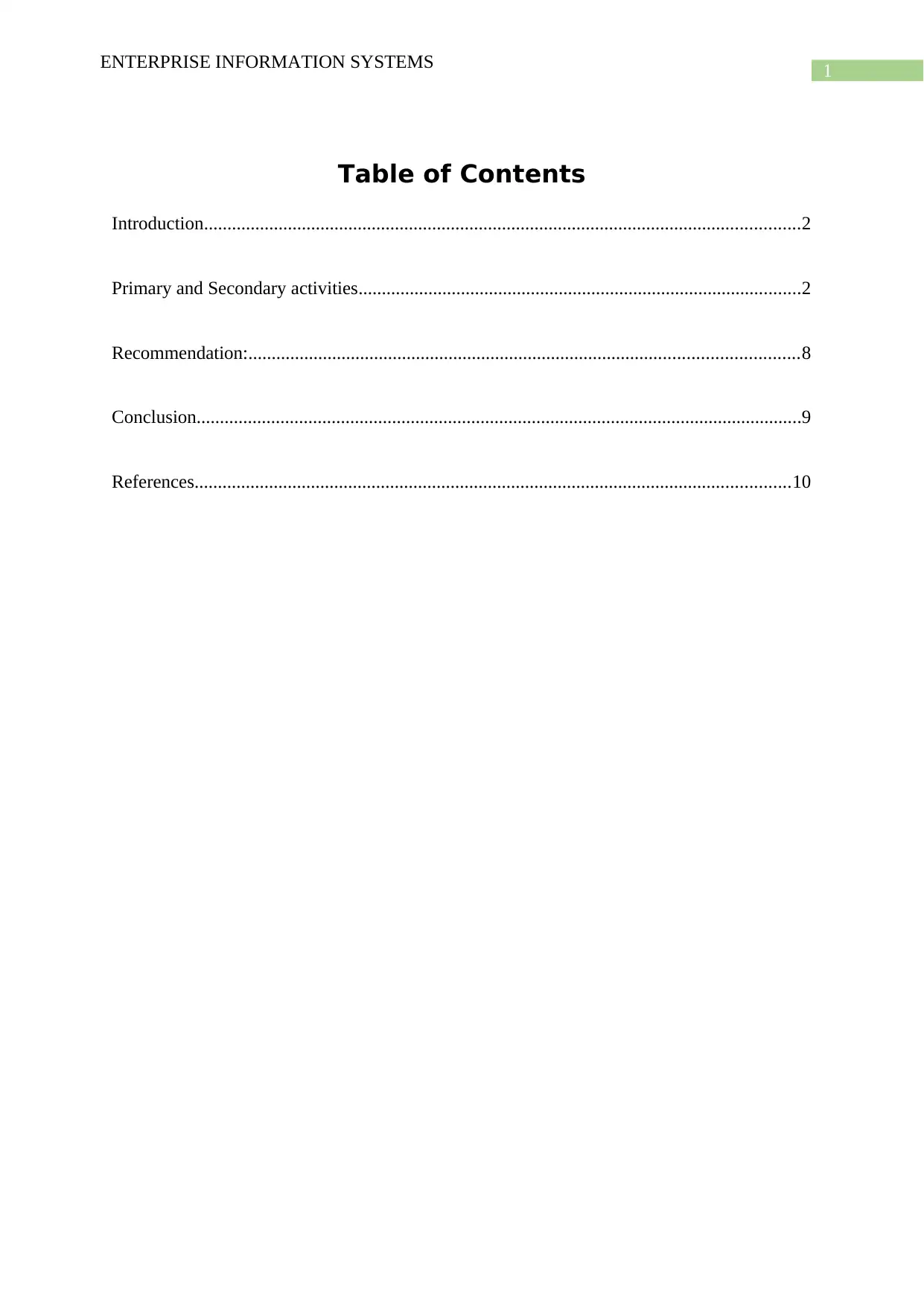
1
ENTERPRISE INFORMATION SYSTEMS
Table of Contents
Introduction................................................................................................................................2
Primary and Secondary activities...............................................................................................2
Recommendation:......................................................................................................................8
Conclusion..................................................................................................................................9
References................................................................................................................................10
ENTERPRISE INFORMATION SYSTEMS
Table of Contents
Introduction................................................................................................................................2
Primary and Secondary activities...............................................................................................2
Recommendation:......................................................................................................................8
Conclusion..................................................................................................................................9
References................................................................................................................................10
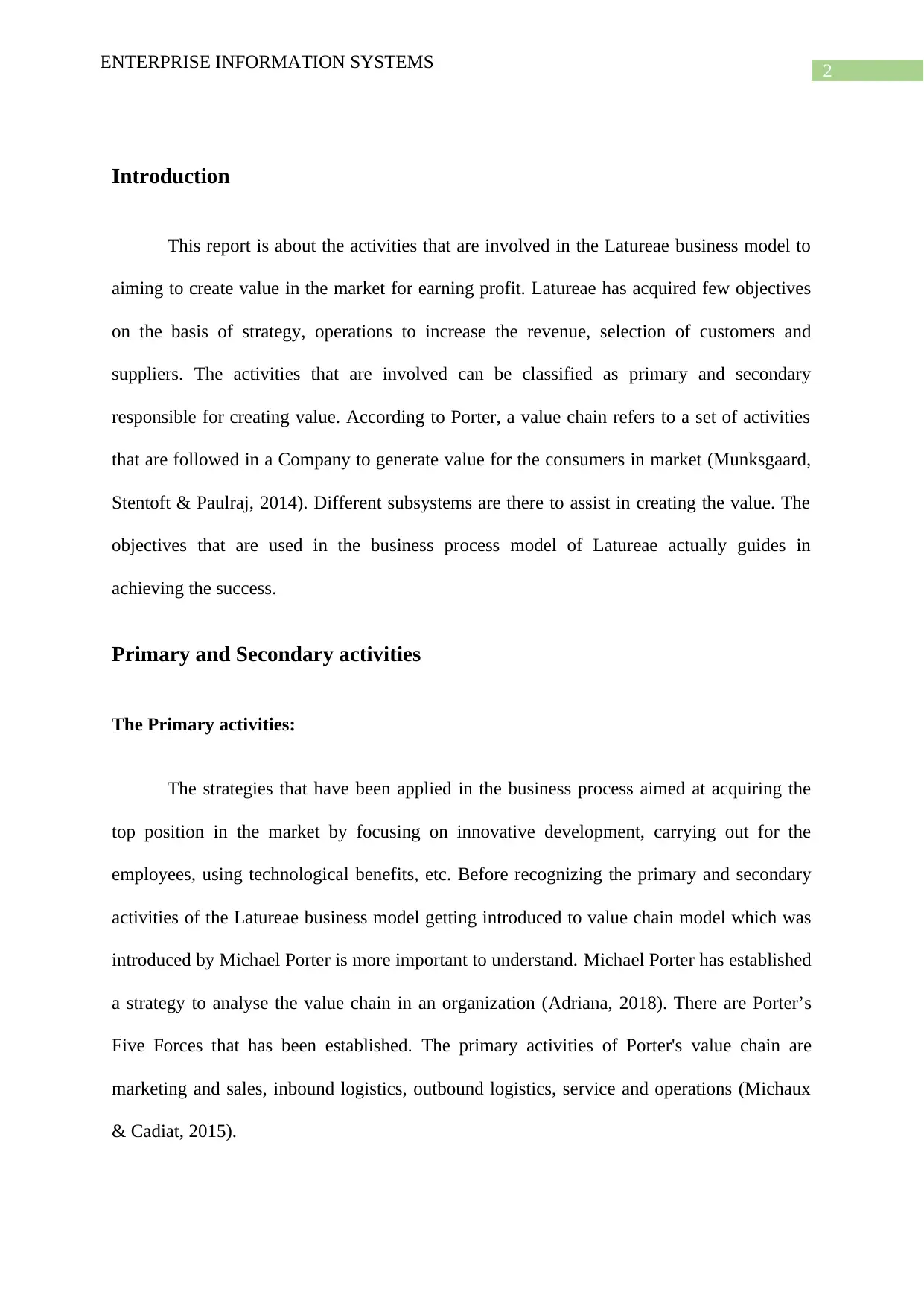
2
ENTERPRISE INFORMATION SYSTEMS
Introduction
This report is about the activities that are involved in the Latureae business model to
aiming to create value in the market for earning profit. Latureae has acquired few objectives
on the basis of strategy, operations to increase the revenue, selection of customers and
suppliers. The activities that are involved can be classified as primary and secondary
responsible for creating value. According to Porter, a value chain refers to a set of activities
that are followed in a Company to generate value for the consumers in market (Munksgaard,
Stentoft & Paulraj, 2014). Different subsystems are there to assist in creating the value. The
objectives that are used in the business process model of Latureae actually guides in
achieving the success.
Primary and Secondary activities
The Primary activities:
The strategies that have been applied in the business process aimed at acquiring the
top position in the market by focusing on innovative development, carrying out for the
employees, using technological benefits, etc. Before recognizing the primary and secondary
activities of the Latureae business model getting introduced to value chain model which was
introduced by Michael Porter is more important to understand. Michael Porter has established
a strategy to analyse the value chain in an organization (Adriana, 2018). There are Porter’s
Five Forces that has been established. The primary activities of Porter's value chain are
marketing and sales, inbound logistics, outbound logistics, service and operations (Michaux
& Cadiat, 2015).
ENTERPRISE INFORMATION SYSTEMS
Introduction
This report is about the activities that are involved in the Latureae business model to
aiming to create value in the market for earning profit. Latureae has acquired few objectives
on the basis of strategy, operations to increase the revenue, selection of customers and
suppliers. The activities that are involved can be classified as primary and secondary
responsible for creating value. According to Porter, a value chain refers to a set of activities
that are followed in a Company to generate value for the consumers in market (Munksgaard,
Stentoft & Paulraj, 2014). Different subsystems are there to assist in creating the value. The
objectives that are used in the business process model of Latureae actually guides in
achieving the success.
Primary and Secondary activities
The Primary activities:
The strategies that have been applied in the business process aimed at acquiring the
top position in the market by focusing on innovative development, carrying out for the
employees, using technological benefits, etc. Before recognizing the primary and secondary
activities of the Latureae business model getting introduced to value chain model which was
introduced by Michael Porter is more important to understand. Michael Porter has established
a strategy to analyse the value chain in an organization (Adriana, 2018). There are Porter’s
Five Forces that has been established. The primary activities of Porter's value chain are
marketing and sales, inbound logistics, outbound logistics, service and operations (Michaux
& Cadiat, 2015).
⊘ This is a preview!⊘
Do you want full access?
Subscribe today to unlock all pages.

Trusted by 1+ million students worldwide
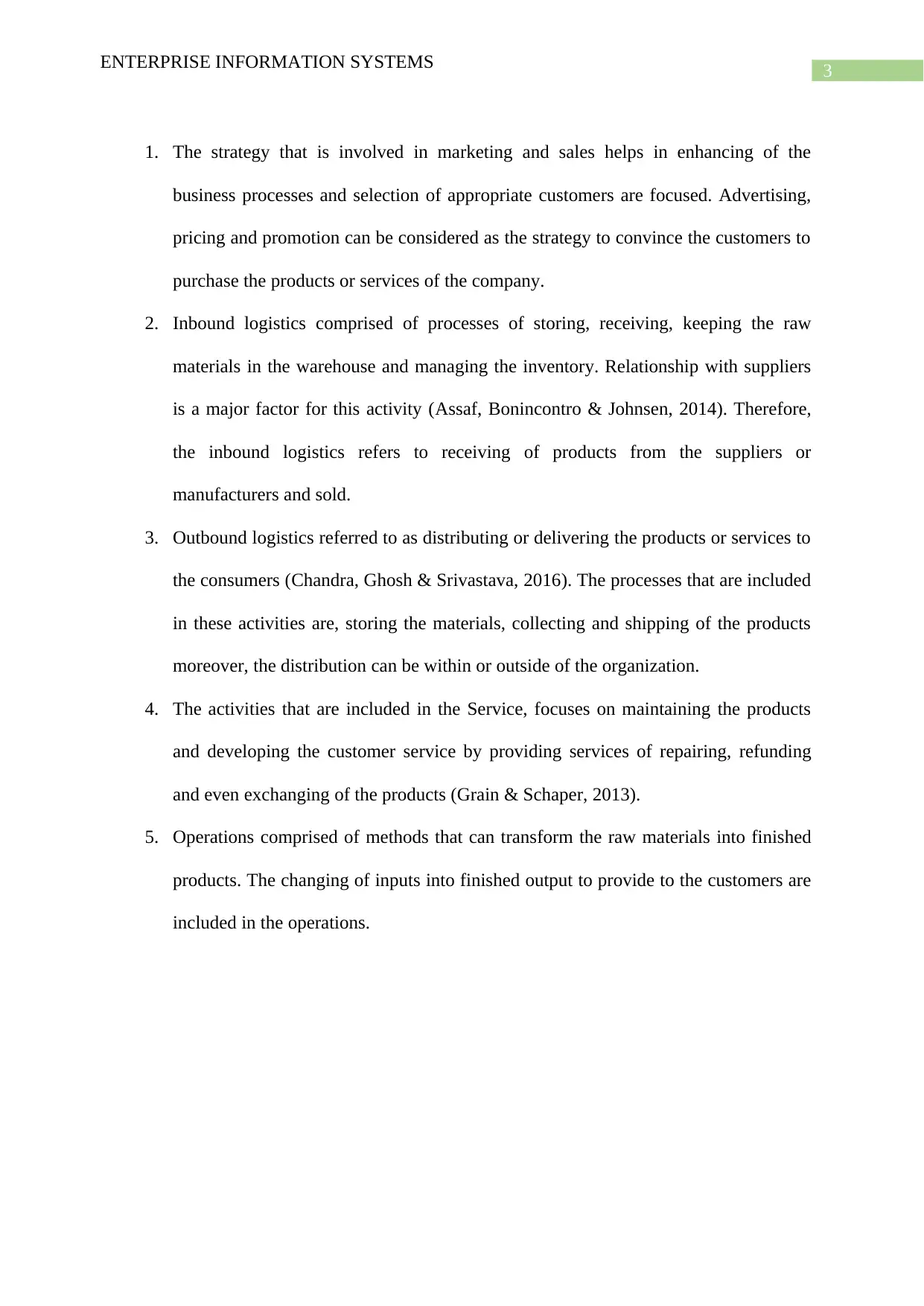
3
ENTERPRISE INFORMATION SYSTEMS
1. The strategy that is involved in marketing and sales helps in enhancing of the
business processes and selection of appropriate customers are focused. Advertising,
pricing and promotion can be considered as the strategy to convince the customers to
purchase the products or services of the company.
2. Inbound logistics comprised of processes of storing, receiving, keeping the raw
materials in the warehouse and managing the inventory. Relationship with suppliers
is a major factor for this activity (Assaf, Bonincontro & Johnsen, 2014). Therefore,
the inbound logistics refers to receiving of products from the suppliers or
manufacturers and sold.
3. Outbound logistics referred to as distributing or delivering the products or services to
the consumers (Chandra, Ghosh & Srivastava, 2016). The processes that are included
in these activities are, storing the materials, collecting and shipping of the products
moreover, the distribution can be within or outside of the organization.
4. The activities that are included in the Service, focuses on maintaining the products
and developing the customer service by providing services of repairing, refunding
and even exchanging of the products (Grain & Schaper, 2013).
5. Operations comprised of methods that can transform the raw materials into finished
products. The changing of inputs into finished output to provide to the customers are
included in the operations.
ENTERPRISE INFORMATION SYSTEMS
1. The strategy that is involved in marketing and sales helps in enhancing of the
business processes and selection of appropriate customers are focused. Advertising,
pricing and promotion can be considered as the strategy to convince the customers to
purchase the products or services of the company.
2. Inbound logistics comprised of processes of storing, receiving, keeping the raw
materials in the warehouse and managing the inventory. Relationship with suppliers
is a major factor for this activity (Assaf, Bonincontro & Johnsen, 2014). Therefore,
the inbound logistics refers to receiving of products from the suppliers or
manufacturers and sold.
3. Outbound logistics referred to as distributing or delivering the products or services to
the consumers (Chandra, Ghosh & Srivastava, 2016). The processes that are included
in these activities are, storing the materials, collecting and shipping of the products
moreover, the distribution can be within or outside of the organization.
4. The activities that are included in the Service, focuses on maintaining the products
and developing the customer service by providing services of repairing, refunding
and even exchanging of the products (Grain & Schaper, 2013).
5. Operations comprised of methods that can transform the raw materials into finished
products. The changing of inputs into finished output to provide to the customers are
included in the operations.
Paraphrase This Document
Need a fresh take? Get an instant paraphrase of this document with our AI Paraphraser
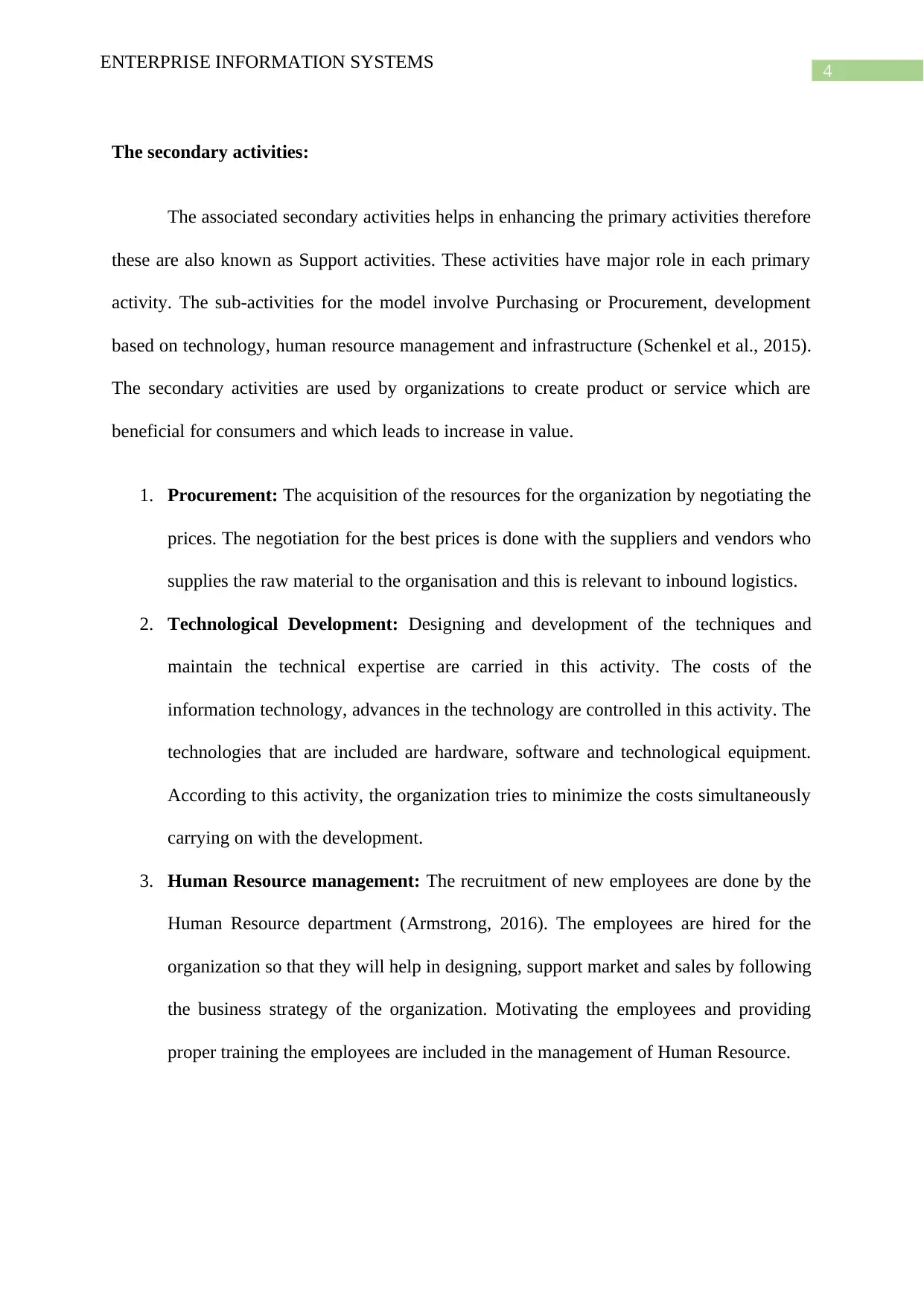
4
ENTERPRISE INFORMATION SYSTEMS
The secondary activities:
The associated secondary activities helps in enhancing the primary activities therefore
these are also known as Support activities. These activities have major role in each primary
activity. The sub-activities for the model involve Purchasing or Procurement, development
based on technology, human resource management and infrastructure (Schenkel et al., 2015).
The secondary activities are used by organizations to create product or service which are
beneficial for consumers and which leads to increase in value.
1. Procurement: The acquisition of the resources for the organization by negotiating the
prices. The negotiation for the best prices is done with the suppliers and vendors who
supplies the raw material to the organisation and this is relevant to inbound logistics.
2. Technological Development: Designing and development of the techniques and
maintain the technical expertise are carried in this activity. The costs of the
information technology, advances in the technology are controlled in this activity. The
technologies that are included are hardware, software and technological equipment.
According to this activity, the organization tries to minimize the costs simultaneously
carrying on with the development.
3. Human Resource management: The recruitment of new employees are done by the
Human Resource department (Armstrong, 2016). The employees are hired for the
organization so that they will help in designing, support market and sales by following
the business strategy of the organization. Motivating the employees and providing
proper training the employees are included in the management of Human Resource.
ENTERPRISE INFORMATION SYSTEMS
The secondary activities:
The associated secondary activities helps in enhancing the primary activities therefore
these are also known as Support activities. These activities have major role in each primary
activity. The sub-activities for the model involve Purchasing or Procurement, development
based on technology, human resource management and infrastructure (Schenkel et al., 2015).
The secondary activities are used by organizations to create product or service which are
beneficial for consumers and which leads to increase in value.
1. Procurement: The acquisition of the resources for the organization by negotiating the
prices. The negotiation for the best prices is done with the suppliers and vendors who
supplies the raw material to the organisation and this is relevant to inbound logistics.
2. Technological Development: Designing and development of the techniques and
maintain the technical expertise are carried in this activity. The costs of the
information technology, advances in the technology are controlled in this activity. The
technologies that are included are hardware, software and technological equipment.
According to this activity, the organization tries to minimize the costs simultaneously
carrying on with the development.
3. Human Resource management: The recruitment of new employees are done by the
Human Resource department (Armstrong, 2016). The employees are hired for the
organization so that they will help in designing, support market and sales by following
the business strategy of the organization. Motivating the employees and providing
proper training the employees are included in the management of Human Resource.
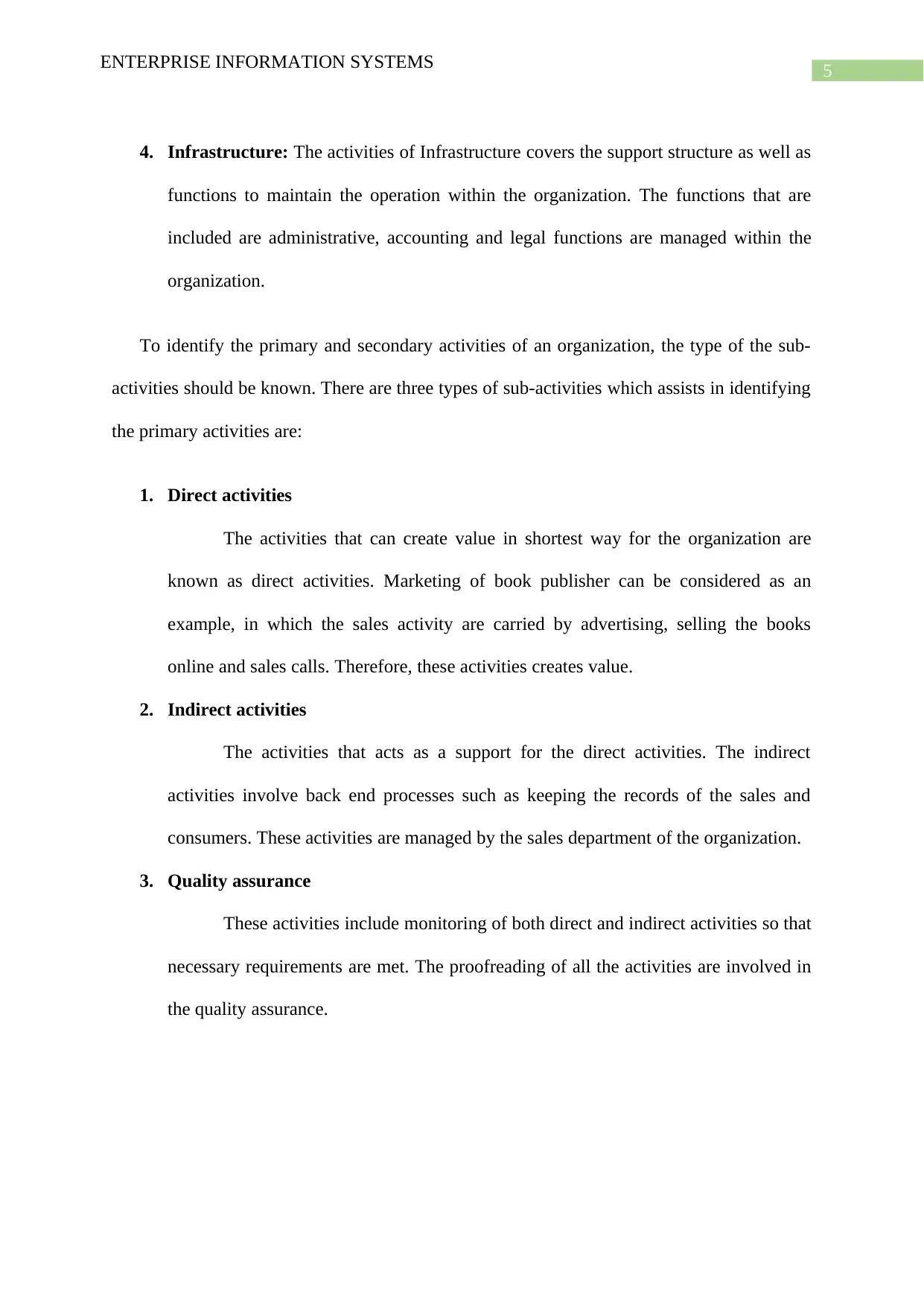
5
ENTERPRISE INFORMATION SYSTEMS
4. Infrastructure: The activities of Infrastructure covers the support structure as well as
functions to maintain the operation within the organization. The functions that are
included are administrative, accounting and legal functions are managed within the
organization.
To identify the primary and secondary activities of an organization, the type of the sub-
activities should be known. There are three types of sub-activities which assists in identifying
the primary activities are:
1. Direct activities
The activities that can create value in shortest way for the organization are
known as direct activities. Marketing of book publisher can be considered as an
example, in which the sales activity are carried by advertising, selling the books
online and sales calls. Therefore, these activities creates value.
2. Indirect activities
The activities that acts as a support for the direct activities. The indirect
activities involve back end processes such as keeping the records of the sales and
consumers. These activities are managed by the sales department of the organization.
3. Quality assurance
These activities include monitoring of both direct and indirect activities so that
necessary requirements are met. The proofreading of all the activities are involved in
the quality assurance.
ENTERPRISE INFORMATION SYSTEMS
4. Infrastructure: The activities of Infrastructure covers the support structure as well as
functions to maintain the operation within the organization. The functions that are
included are administrative, accounting and legal functions are managed within the
organization.
To identify the primary and secondary activities of an organization, the type of the sub-
activities should be known. There are three types of sub-activities which assists in identifying
the primary activities are:
1. Direct activities
The activities that can create value in shortest way for the organization are
known as direct activities. Marketing of book publisher can be considered as an
example, in which the sales activity are carried by advertising, selling the books
online and sales calls. Therefore, these activities creates value.
2. Indirect activities
The activities that acts as a support for the direct activities. The indirect
activities involve back end processes such as keeping the records of the sales and
consumers. These activities are managed by the sales department of the organization.
3. Quality assurance
These activities include monitoring of both direct and indirect activities so that
necessary requirements are met. The proofreading of all the activities are involved in
the quality assurance.
⊘ This is a preview!⊘
Do you want full access?
Subscribe today to unlock all pages.

Trusted by 1+ million students worldwide
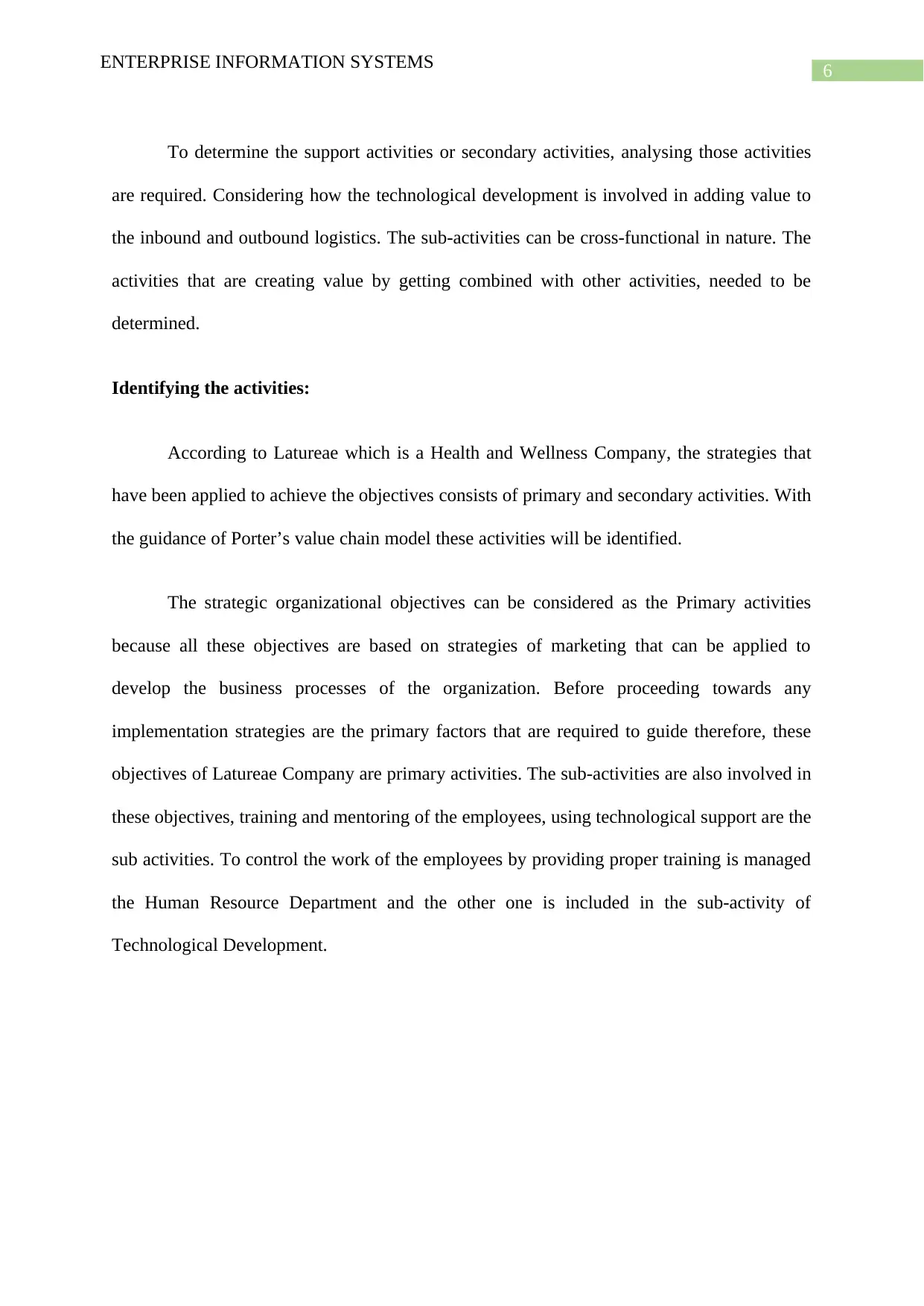
6
ENTERPRISE INFORMATION SYSTEMS
To determine the support activities or secondary activities, analysing those activities
are required. Considering how the technological development is involved in adding value to
the inbound and outbound logistics. The sub-activities can be cross-functional in nature. The
activities that are creating value by getting combined with other activities, needed to be
determined.
Identifying the activities:
According to Latureae which is a Health and Wellness Company, the strategies that
have been applied to achieve the objectives consists of primary and secondary activities. With
the guidance of Porter’s value chain model these activities will be identified.
The strategic organizational objectives can be considered as the Primary activities
because all these objectives are based on strategies of marketing that can be applied to
develop the business processes of the organization. Before proceeding towards any
implementation strategies are the primary factors that are required to guide therefore, these
objectives of Latureae Company are primary activities. The sub-activities are also involved in
these objectives, training and mentoring of the employees, using technological support are the
sub activities. To control the work of the employees by providing proper training is managed
the Human Resource Department and the other one is included in the sub-activity of
Technological Development.
ENTERPRISE INFORMATION SYSTEMS
To determine the support activities or secondary activities, analysing those activities
are required. Considering how the technological development is involved in adding value to
the inbound and outbound logistics. The sub-activities can be cross-functional in nature. The
activities that are creating value by getting combined with other activities, needed to be
determined.
Identifying the activities:
According to Latureae which is a Health and Wellness Company, the strategies that
have been applied to achieve the objectives consists of primary and secondary activities. With
the guidance of Porter’s value chain model these activities will be identified.
The strategic organizational objectives can be considered as the Primary activities
because all these objectives are based on strategies of marketing that can be applied to
develop the business processes of the organization. Before proceeding towards any
implementation strategies are the primary factors that are required to guide therefore, these
objectives of Latureae Company are primary activities. The sub-activities are also involved in
these objectives, training and mentoring of the employees, using technological support are the
sub activities. To control the work of the employees by providing proper training is managed
the Human Resource Department and the other one is included in the sub-activity of
Technological Development.
Paraphrase This Document
Need a fresh take? Get an instant paraphrase of this document with our AI Paraphraser
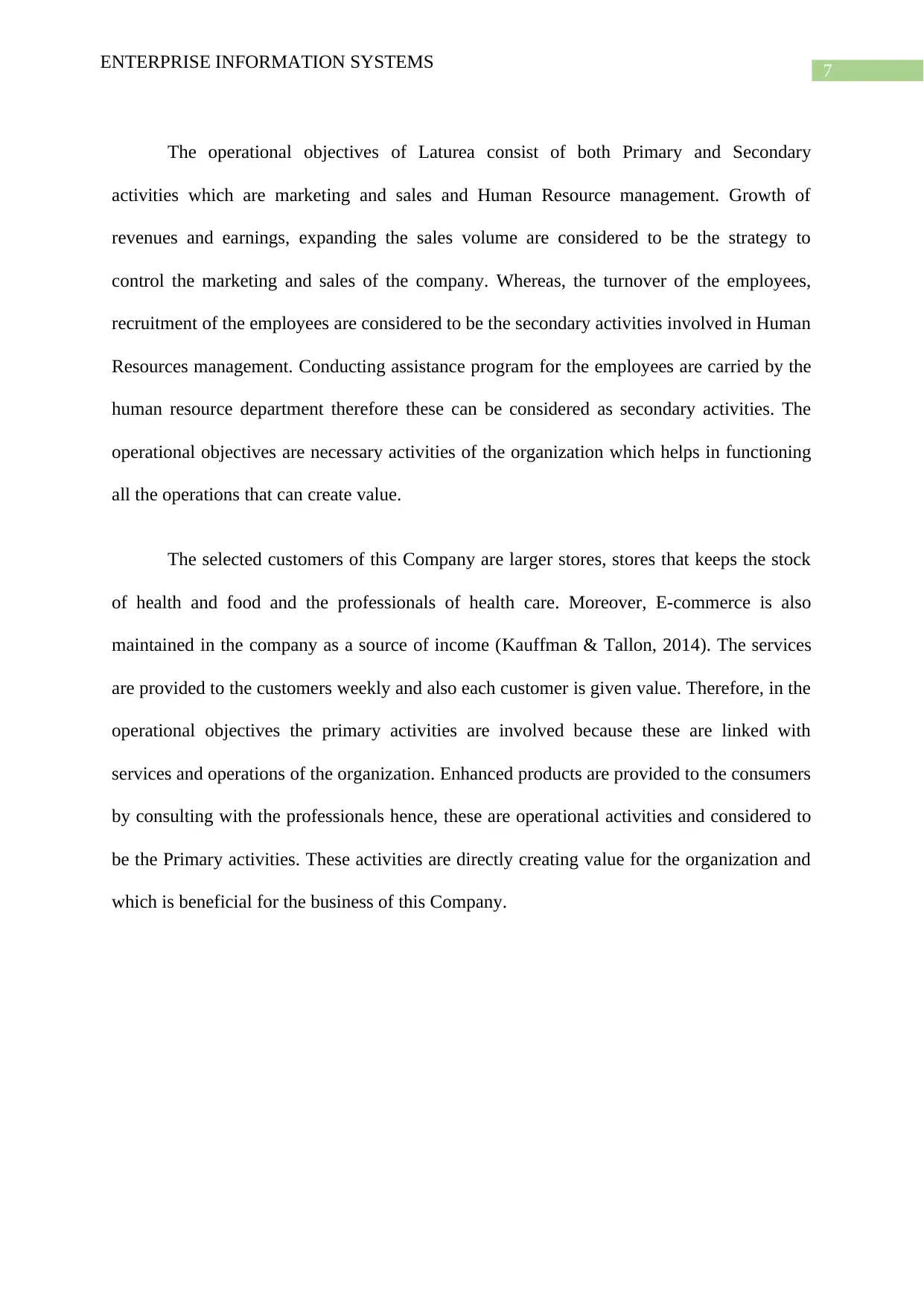
7
ENTERPRISE INFORMATION SYSTEMS
The operational objectives of Laturea consist of both Primary and Secondary
activities which are marketing and sales and Human Resource management. Growth of
revenues and earnings, expanding the sales volume are considered to be the strategy to
control the marketing and sales of the company. Whereas, the turnover of the employees,
recruitment of the employees are considered to be the secondary activities involved in Human
Resources management. Conducting assistance program for the employees are carried by the
human resource department therefore these can be considered as secondary activities. The
operational objectives are necessary activities of the organization which helps in functioning
all the operations that can create value.
The selected customers of this Company are larger stores, stores that keeps the stock
of health and food and the professionals of health care. Moreover, E-commerce is also
maintained in the company as a source of income (Kauffman & Tallon, 2014). The services
are provided to the customers weekly and also each customer is given value. Therefore, in the
operational objectives the primary activities are involved because these are linked with
services and operations of the organization. Enhanced products are provided to the consumers
by consulting with the professionals hence, these are operational activities and considered to
be the Primary activities. These activities are directly creating value for the organization and
which is beneficial for the business of this Company.
ENTERPRISE INFORMATION SYSTEMS
The operational objectives of Laturea consist of both Primary and Secondary
activities which are marketing and sales and Human Resource management. Growth of
revenues and earnings, expanding the sales volume are considered to be the strategy to
control the marketing and sales of the company. Whereas, the turnover of the employees,
recruitment of the employees are considered to be the secondary activities involved in Human
Resources management. Conducting assistance program for the employees are carried by the
human resource department therefore these can be considered as secondary activities. The
operational objectives are necessary activities of the organization which helps in functioning
all the operations that can create value.
The selected customers of this Company are larger stores, stores that keeps the stock
of health and food and the professionals of health care. Moreover, E-commerce is also
maintained in the company as a source of income (Kauffman & Tallon, 2014). The services
are provided to the customers weekly and also each customer is given value. Therefore, in the
operational objectives the primary activities are involved because these are linked with
services and operations of the organization. Enhanced products are provided to the consumers
by consulting with the professionals hence, these are operational activities and considered to
be the Primary activities. These activities are directly creating value for the organization and
which is beneficial for the business of this Company.
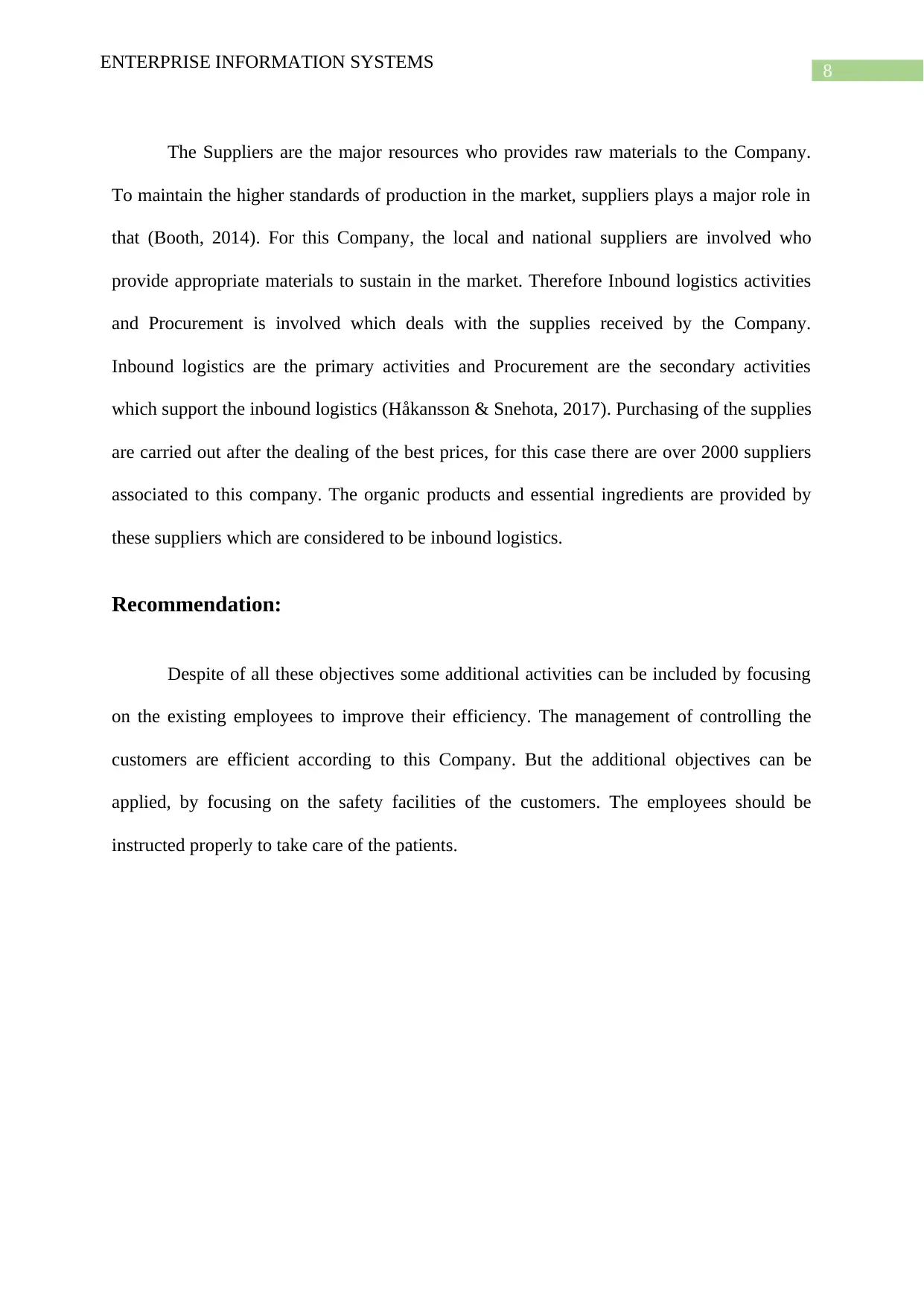
8
ENTERPRISE INFORMATION SYSTEMS
The Suppliers are the major resources who provides raw materials to the Company.
To maintain the higher standards of production in the market, suppliers plays a major role in
that (Booth, 2014). For this Company, the local and national suppliers are involved who
provide appropriate materials to sustain in the market. Therefore Inbound logistics activities
and Procurement is involved which deals with the supplies received by the Company.
Inbound logistics are the primary activities and Procurement are the secondary activities
which support the inbound logistics (Håkansson & Snehota, 2017 ). Purchasing of the supplies
are carried out after the dealing of the best prices, for this case there are over 2000 suppliers
associated to this company. The organic products and essential ingredients are provided by
these suppliers which are considered to be inbound logistics.
Recommendation:
Despite of all these objectives some additional activities can be included by focusing
on the existing employees to improve their efficiency. The management of controlling the
customers are efficient according to this Company. But the additional objectives can be
applied, by focusing on the safety facilities of the customers. The employees should be
instructed properly to take care of the patients.
ENTERPRISE INFORMATION SYSTEMS
The Suppliers are the major resources who provides raw materials to the Company.
To maintain the higher standards of production in the market, suppliers plays a major role in
that (Booth, 2014). For this Company, the local and national suppliers are involved who
provide appropriate materials to sustain in the market. Therefore Inbound logistics activities
and Procurement is involved which deals with the supplies received by the Company.
Inbound logistics are the primary activities and Procurement are the secondary activities
which support the inbound logistics (Håkansson & Snehota, 2017 ). Purchasing of the supplies
are carried out after the dealing of the best prices, for this case there are over 2000 suppliers
associated to this company. The organic products and essential ingredients are provided by
these suppliers which are considered to be inbound logistics.
Recommendation:
Despite of all these objectives some additional activities can be included by focusing
on the existing employees to improve their efficiency. The management of controlling the
customers are efficient according to this Company. But the additional objectives can be
applied, by focusing on the safety facilities of the customers. The employees should be
instructed properly to take care of the patients.
⊘ This is a preview!⊘
Do you want full access?
Subscribe today to unlock all pages.

Trusted by 1+ million students worldwide
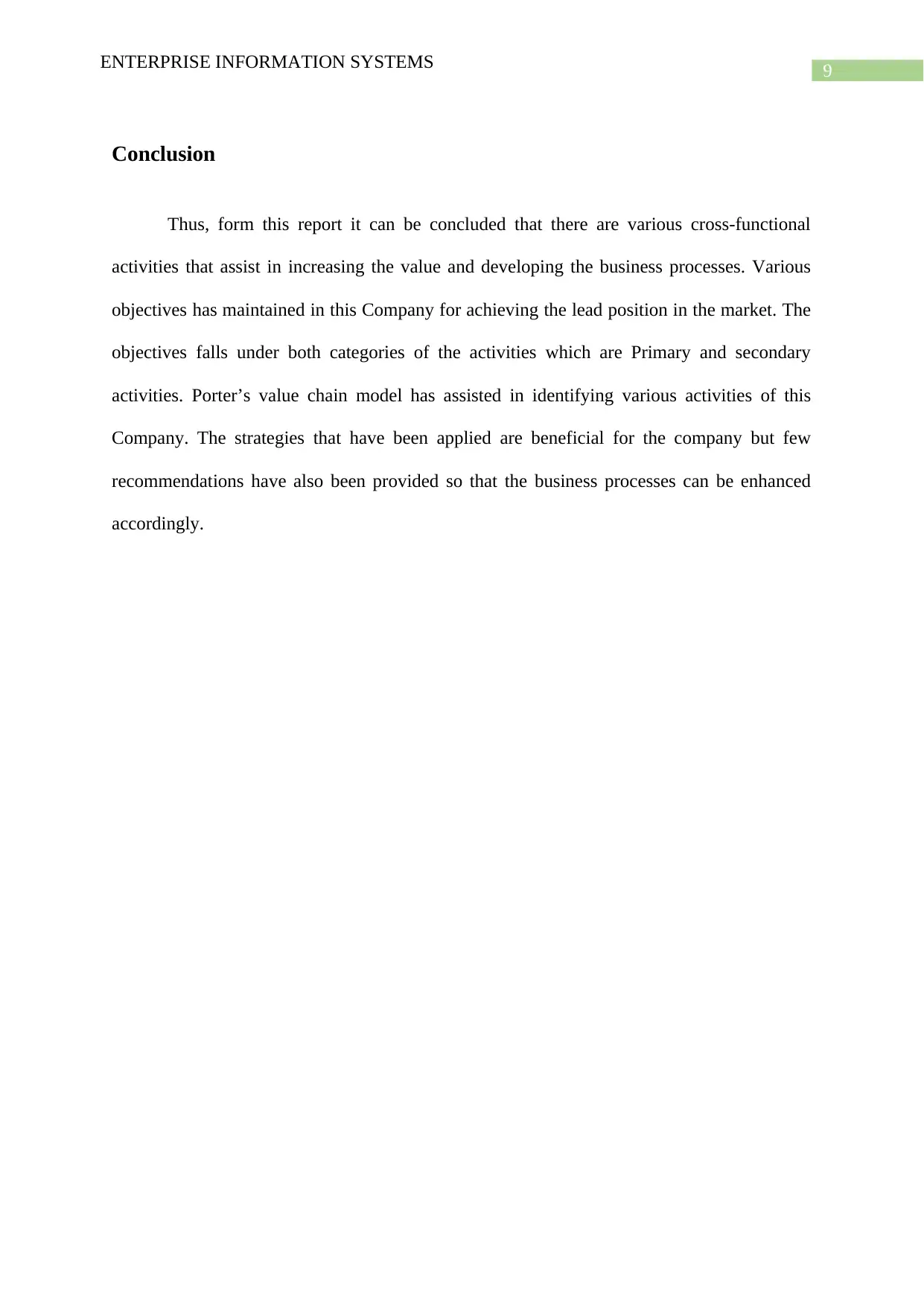
9
ENTERPRISE INFORMATION SYSTEMS
Conclusion
Thus, form this report it can be concluded that there are various cross-functional
activities that assist in increasing the value and developing the business processes. Various
objectives has maintained in this Company for achieving the lead position in the market. The
objectives falls under both categories of the activities which are Primary and secondary
activities. Porter’s value chain model has assisted in identifying various activities of this
Company. The strategies that have been applied are beneficial for the company but few
recommendations have also been provided so that the business processes can be enhanced
accordingly.
ENTERPRISE INFORMATION SYSTEMS
Conclusion
Thus, form this report it can be concluded that there are various cross-functional
activities that assist in increasing the value and developing the business processes. Various
objectives has maintained in this Company for achieving the lead position in the market. The
objectives falls under both categories of the activities which are Primary and secondary
activities. Porter’s value chain model has assisted in identifying various activities of this
Company. The strategies that have been applied are beneficial for the company but few
recommendations have also been provided so that the business processes can be enhanced
accordingly.
Paraphrase This Document
Need a fresh take? Get an instant paraphrase of this document with our AI Paraphraser
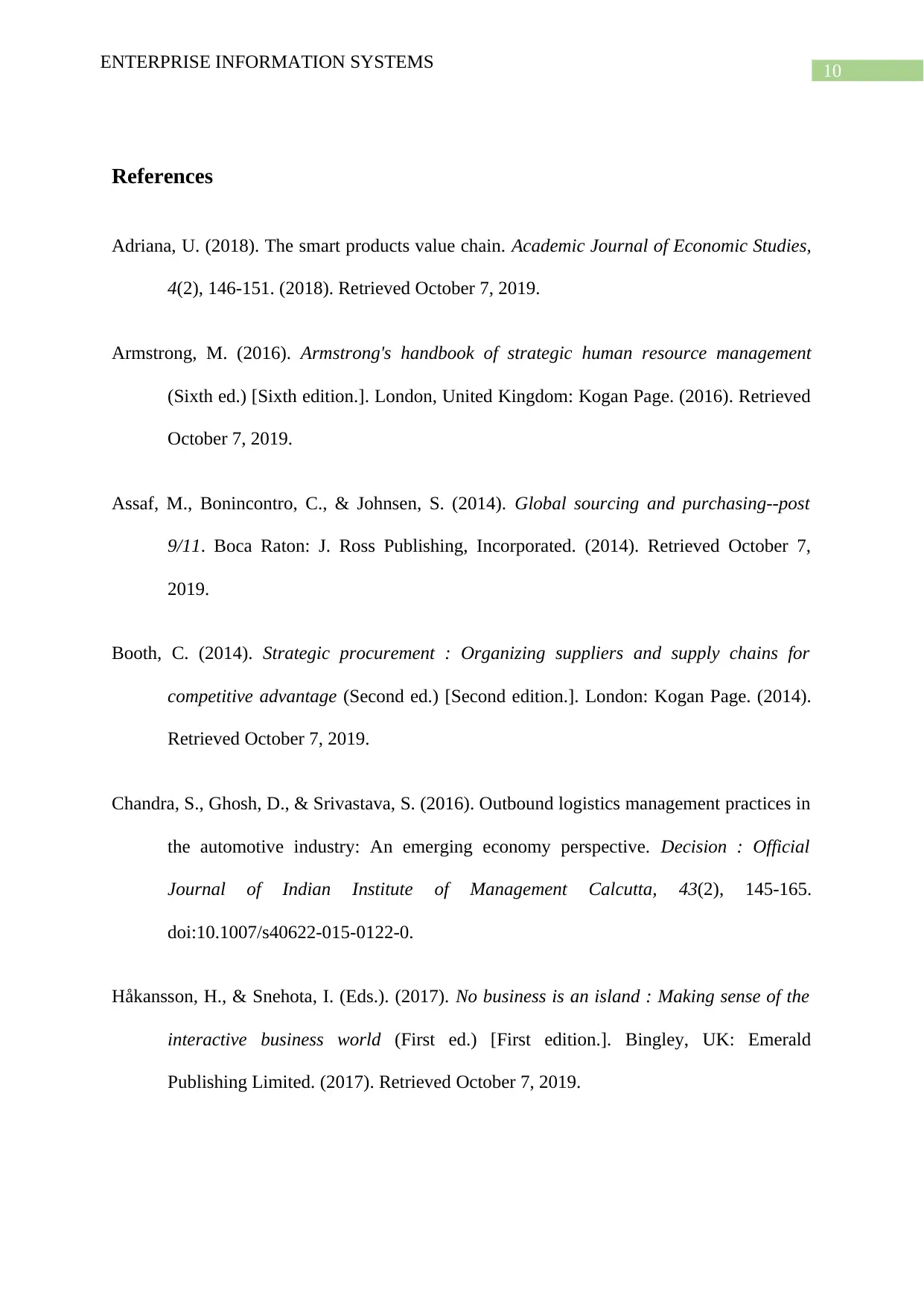
10
ENTERPRISE INFORMATION SYSTEMS
References
Adriana, U. (2018). The smart products value chain. Academic Journal of Economic Studies,
4(2), 146-151. (2018). Retrieved October 7, 2019.
Armstrong, M. (2016). Armstrong's handbook of strategic human resource management
(Sixth ed.) [Sixth edition.]. London, United Kingdom: Kogan Page. (2016). Retrieved
October 7, 2019.
Assaf, M., Bonincontro, C., & Johnsen, S. (2014). Global sourcing and purchasing--post
9/11. Boca Raton: J. Ross Publishing, Incorporated. (2014). Retrieved October 7,
2019.
Booth, C. (2014). Strategic procurement : Organizing suppliers and supply chains for
competitive advantage (Second ed.) [Second edition.]. London: Kogan Page. (2014).
Retrieved October 7, 2019.
Chandra, S., Ghosh, D., & Srivastava, S. (2016). Outbound logistics management practices in
the automotive industry: An emerging economy perspective. Decision : Official
Journal of Indian Institute of Management Calcutta, 43(2), 145-165.
doi:10.1007/s40622-015-0122-0.
Håkansson, H., & Snehota, I. (Eds.). (2017). No business is an island : Making sense of the
interactive business world (First ed.) [First edition.]. Bingley, UK: Emerald
Publishing Limited. (2017). Retrieved October 7, 2019.
ENTERPRISE INFORMATION SYSTEMS
References
Adriana, U. (2018). The smart products value chain. Academic Journal of Economic Studies,
4(2), 146-151. (2018). Retrieved October 7, 2019.
Armstrong, M. (2016). Armstrong's handbook of strategic human resource management
(Sixth ed.) [Sixth edition.]. London, United Kingdom: Kogan Page. (2016). Retrieved
October 7, 2019.
Assaf, M., Bonincontro, C., & Johnsen, S. (2014). Global sourcing and purchasing--post
9/11. Boca Raton: J. Ross Publishing, Incorporated. (2014). Retrieved October 7,
2019.
Booth, C. (2014). Strategic procurement : Organizing suppliers and supply chains for
competitive advantage (Second ed.) [Second edition.]. London: Kogan Page. (2014).
Retrieved October 7, 2019.
Chandra, S., Ghosh, D., & Srivastava, S. (2016). Outbound logistics management practices in
the automotive industry: An emerging economy perspective. Decision : Official
Journal of Indian Institute of Management Calcutta, 43(2), 145-165.
doi:10.1007/s40622-015-0122-0.
Håkansson, H., & Snehota, I. (Eds.). (2017). No business is an island : Making sense of the
interactive business world (First ed.) [First edition.]. Bingley, UK: Emerald
Publishing Limited. (2017). Retrieved October 7, 2019.
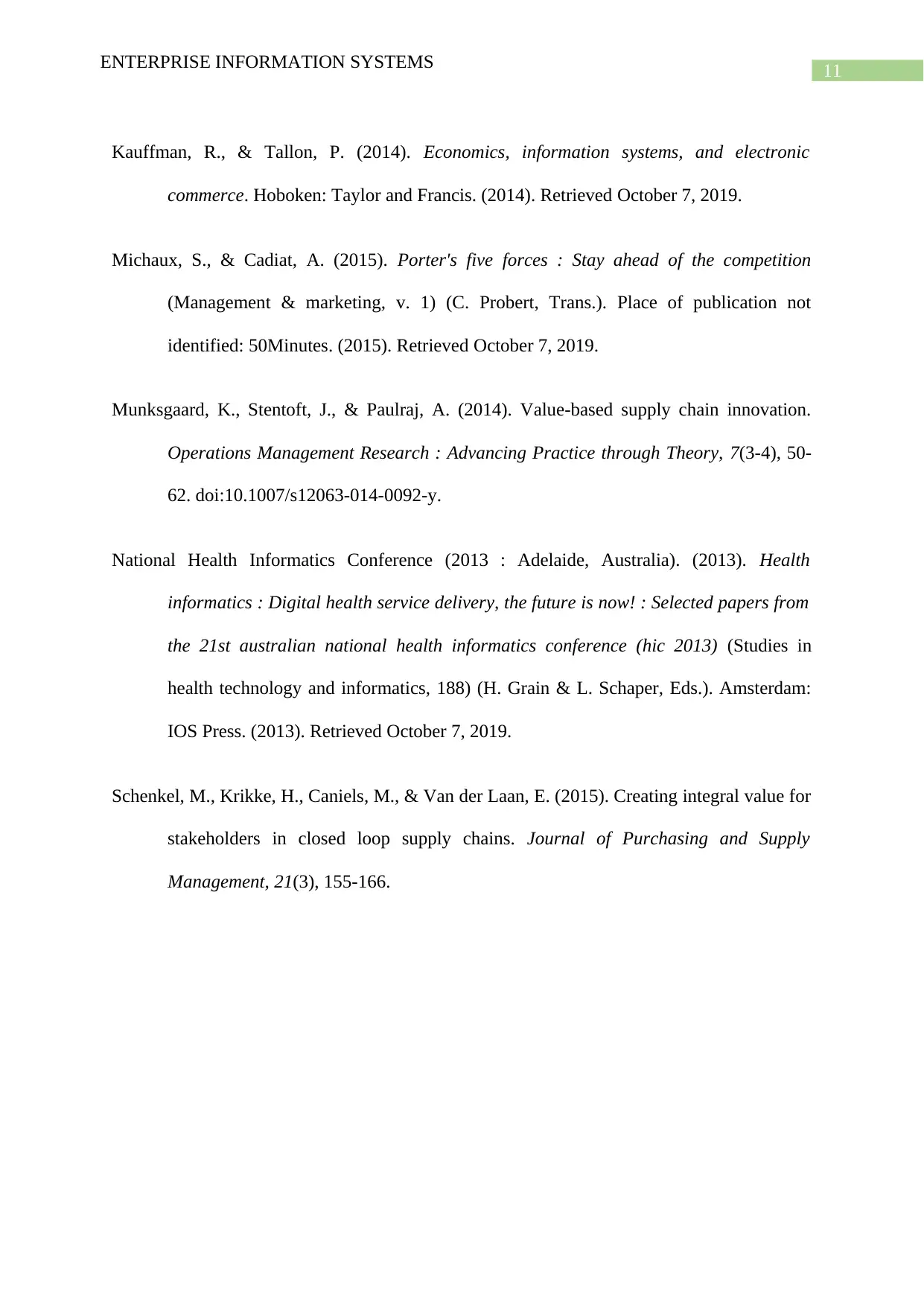
11
ENTERPRISE INFORMATION SYSTEMS
Kauffman, R., & Tallon, P. (2014). Economics, information systems, and electronic
commerce. Hoboken: Taylor and Francis. (2014). Retrieved October 7, 2019.
Michaux, S., & Cadiat, A. (2015). Porter's five forces : Stay ahead of the competition
(Management & marketing, v. 1) (C. Probert, Trans.). Place of publication not
identified: 50Minutes. (2015). Retrieved October 7, 2019.
Munksgaard, K., Stentoft, J., & Paulraj, A. (2014). Value-based supply chain innovation.
Operations Management Research : Advancing Practice through Theory, 7(3-4), 50-
62. doi:10.1007/s12063-014-0092-y.
National Health Informatics Conference (2013 : Adelaide, Australia). (2013). Health
informatics : Digital health service delivery, the future is now! : Selected papers from
the 21st australian national health informatics conference (hic 2013) (Studies in
health technology and informatics, 188) (H. Grain & L. Schaper, Eds.). Amsterdam:
IOS Press. (2013). Retrieved October 7, 2019.
Schenkel, M., Krikke, H., Caniels, M., & Van der Laan, E. (2015). Creating integral value for
stakeholders in closed loop supply chains. Journal of Purchasing and Supply
Management, 21(3), 155-166.
ENTERPRISE INFORMATION SYSTEMS
Kauffman, R., & Tallon, P. (2014). Economics, information systems, and electronic
commerce. Hoboken: Taylor and Francis. (2014). Retrieved October 7, 2019.
Michaux, S., & Cadiat, A. (2015). Porter's five forces : Stay ahead of the competition
(Management & marketing, v. 1) (C. Probert, Trans.). Place of publication not
identified: 50Minutes. (2015). Retrieved October 7, 2019.
Munksgaard, K., Stentoft, J., & Paulraj, A. (2014). Value-based supply chain innovation.
Operations Management Research : Advancing Practice through Theory, 7(3-4), 50-
62. doi:10.1007/s12063-014-0092-y.
National Health Informatics Conference (2013 : Adelaide, Australia). (2013). Health
informatics : Digital health service delivery, the future is now! : Selected papers from
the 21st australian national health informatics conference (hic 2013) (Studies in
health technology and informatics, 188) (H. Grain & L. Schaper, Eds.). Amsterdam:
IOS Press. (2013). Retrieved October 7, 2019.
Schenkel, M., Krikke, H., Caniels, M., & Van der Laan, E. (2015). Creating integral value for
stakeholders in closed loop supply chains. Journal of Purchasing and Supply
Management, 21(3), 155-166.
⊘ This is a preview!⊘
Do you want full access?
Subscribe today to unlock all pages.

Trusted by 1+ million students worldwide
1 out of 12
Related Documents
Your All-in-One AI-Powered Toolkit for Academic Success.
+13062052269
info@desklib.com
Available 24*7 on WhatsApp / Email
![[object Object]](/_next/static/media/star-bottom.7253800d.svg)
Unlock your academic potential
Copyright © 2020–2025 A2Z Services. All Rights Reserved. Developed and managed by ZUCOL.




